-
- Consumables
- Cell Culture Dishes (106)
- Bags (227)
- Cell Culture Flasks (109)
- Cell Scrapers and Lifters (10)
- Cell Strainers (16)
- Consumables Recycling (35)
- Cuvettes (73)
- Filter Membranes (1726)
- Filtration Devices (1183)
- Gloves (906)
- Inoculation Loops, Spreaders, Needles (84)
- Incubation Trays (22)
- Microplates (425)
- Microscope Slides (330)
- Pasteur Pipets (15)
- Pipette Tips (711)
- Reservoirs (55)
- Tubes and Vials (770)
- Transfer Pipettes (126)
- Sealing Film (120)
- Serological Pipettes (160)
- Weighing Boats and Papers (81)
- Reagents
- Extraction Isolation and Purification Kits (1434)
- Agarose (28)
- Culture Media (1161)
- Gel Electrophoresis (26)
- Nucleotides (42)
- Nucleic Acid Isolation & Purification (98)
- qPCR Master Mix Kits (133)
- Recombinant Proteins (284)
- Water (58)
- Western Blot (40)
- Antibodies (45960)
- Hyclone Media (521)
- Equipment
- Bottletop Dispensers (318)
- Chiller (123)
- Scales and Balances (1187)
- Calibration Weights (9)
- Centrifuges (236)
- Incubators (93)
- Microbiology Incubators (27)
- Digital Burettes (32)
- Freezer Racks (552)
- Freezers and Refrigerators (647)
- Homogenizers (72)
- Hotplates and Hotplate Stirrers (88)
- Hotplate Stirrer Accessories (31)
- Lab Jacks (20)
- Microplate Mixers (20)
- Microscopes (58)
- Ovens (135)
- Overhead Stirrers and Stirrers (215)
- Pipettes (406)
- Roller Bottles (49)
- Roller Mixers (12)
- Rotary Evaporator (49)
- Seating (10)
- Shakers and Rockers (334)
- Thermal Cyclers (10)
- Tube Racks, Cryoboxes & Coolers (411)
- Vacuum Pump
- Water Baths (215)
- Test and Measurements (14)
-

MICROCENTRIFUGE TUBES
Buying Guide
In this issue:
- Tube Capacity
- Cap Type
- Sterility
- Tube bottom
- Surface Type
- Color
- Packaging
Introduction
With so many options available, it can be difficult to identify the best microcentrifuge tube for your research needs. The abundance of vendors and features complicates efforts to find the best microcentrifuge tube, making shopping an unnecessarily difficult process. To remedy this issue, we’ve designed a microcentrifuge tube buying guide that will familiarize you with the key features of a microcentrifuge tube such as tube capacity, cap types, sterility, autoclavability, and relative centrifugal force (RCF) ratings, so that you know what to look for when shopping. Whether you’re an undergrad that is new to the lab or a seasoned post-doc, there is sure to be something of interest to you here.
Tube Capacity
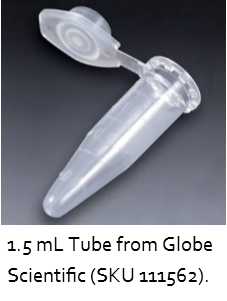
The amount of liquid a microcentrifuge tube can hold is the first feature to consider as part of your selection process. Microcentrifuge tube capacities range from 0.5 to 2.0 mL with the most popular tube volume being 1.5 mL.
1.5 mL tubes are popular because they exceed the required capacity for most molecular biology samples and are generally cheaper than higher capacity tubes. In addition to cost savings, most centrifuges, tube racks, and cryoboxes are designed to accommodate standard 1.5 mL tubes, making them a convenient option. During your time in the lab you may have noticed some 1.5 mL microcentrifuge tubes fill beyond the final 1.5 mL graduation mark while others do not. In these cases, the actual capacity of a tube is ~1.7 mL while the graduation ends at 1.5 mL.
Whether or not this extra space is available varies on from one manufacturer to another. Argos Scientific, Globe Scientific, Heathrow Scientific, and BrandTech are examples of manufacturers that provide 1.5 mL microcentrifuge tubes with some room above the 1.5 mL graduation mark. Bel-Art and CELLTREAT on the other hand do not provide additional space above the graduation mark.
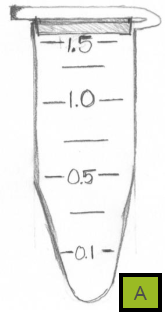 |
Extra space varies from one brand to another, typically, this space amounts to approximately 0.2 mL. | 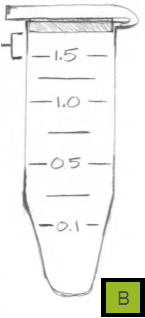 |
Figure 2. Variations of the 1.5 mL microcentrifuge tube. In the first variation, Image A, there is effectively no space between the highest graduation mark on the tube and the bottom of the tube cap. In the second variation, Image B, there is a noticeable amount of space above the highest graduation mark on the tube, 1.5 mL, and the bottom of the tube cap. This additional space is available in tubes manufactured by Argos Scientific, Globe Scientific, Heathrow Scientific, and BrandTech.
In applications where sample volume nears the 1.5 mL mark and thus the tube cap, consider purchasing a 1.8 or 2.0 mL microcentrifuge tube as tube caps are a source of contamination and the sample may spill over in some instances. Bio Plas is one manufacturer that makes a variety of 1.8 mL and 2.0 mL tubes including standard, high spin, and screw cap tubes. It is important to note that 1.8 and 2.0 mL tubes occupy a similar footprint to the standard 1.5 mL microcentrifuge tube and should be compatible with the same equipment.
Cap Type
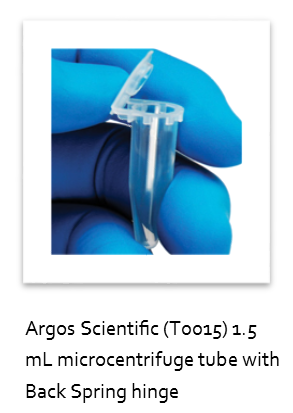 Cap type is an important feature to consider because of the impact that it can have on both the integrity of your sample and the cost to the lab. The most common cap types are the snap cap, ideal for one-time use applications like the aliquoting of a sample for incubation, and screw cap,
Cap type is an important feature to consider because of the impact that it can have on both the integrity of your sample and the cost to the lab. The most common cap types are the snap cap, ideal for one-time use applications like the aliquoting of a sample for incubation, and screw cap,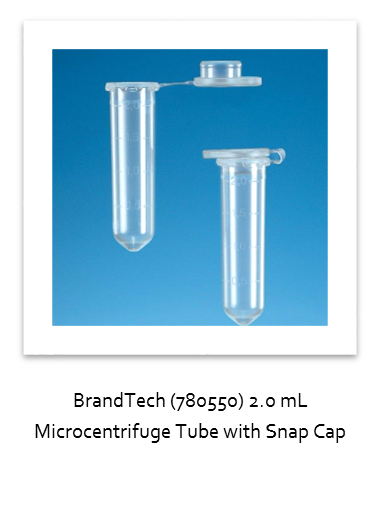 ideal for sample storage and in applications that require a series of openings and closings of the tube.
ideal for sample storage and in applications that require a series of openings and closings of the tube.
The snap cap, the most common cap type, closes shut with pressure, producing a distinct “snapping” sound. The hinge attaching a snap cap to the tube may wear down after repeated use, and, as such, these caps are not ideal for applications that require multiple openings and closures of the tube. You’ll find tubes that feature snap caps are typically cheaper than those with screw caps.
Additional features to consider when purchasing a snap cap include hinge type, a secure lock, and cap top. The standard microcentrifuge tube hinge is flexible and wears with repeated use. New hinge designs allow for single handed opening of the microcentrifuge tubes and reduced wear over time.
Secure locks are used to secure the cap during centrifugation and vortexing. The secure lock will prevent accidental openings of the microcentrifuge tube and reduce the chance of the lid opening during centrifugation.
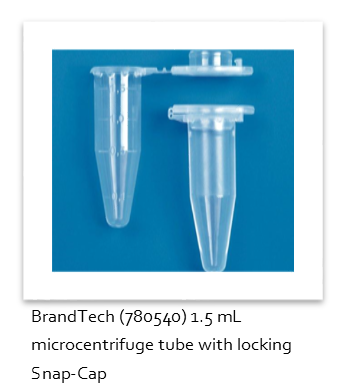 This is extremely important for applications considered high spin. Cap tops may be flat and frosted or designed for piercing by a needle. Easy pierce caps typically have a membrane, a thin, uniform plastic, allowing for easy sample access by a needle. The easy pierce cap is useful for maintaining sample sterility.
This is extremely important for applications considered high spin. Cap tops may be flat and frosted or designed for piercing by a needle. Easy pierce caps typically have a membrane, a thin, uniform plastic, allowing for easy sample access by a needle. The easy pierce cap is useful for maintaining sample sterility.
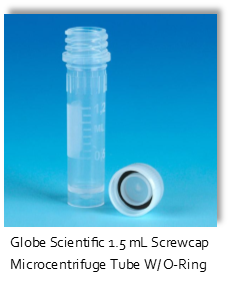 The screw cap is durable and provides a secure seal that is ideal for storing samples. This cap has no hinge and maintains its integrity through a series of openings and closings of the tube. Some screw caps, like the one below, may include an O-ring seal which prevents sample loss from evaporation or leaking while handling.
The screw cap is durable and provides a secure seal that is ideal for storing samples. This cap has no hinge and maintains its integrity through a series of openings and closings of the tube. Some screw caps, like the one below, may include an O-ring seal which prevents sample loss from evaporation or leaking while handling.
Buying Tip. Screw caps can be sold separately from tubes, so during the buying process, ensure that the “screw cap” microcentrifuge tube does in fact include the cap itself.
Sterility, Nuclease Free, and Autoclavability
Sterility. If your sample is sensitive to contamination by foreign microbes, then the sterility of a microcentrifuge tube is an important factor to consider. While a sterile consumable is, by its very definition, free of living microorganisms, sterilization methods and certifications vary between vendors. For information about sterile certifications on products we distribute, contact as at support@sycamorebio.com.
Buying Tip. Sterile microcentrifuge tubes are not always nuclease free. Conversely, nuclease free products may not be sterile. Plastic sterilization employs the use of γ-radiation, and, while γ-radiation kills foreign microbes, mutates DNA, and denatures some enzymes, it will not remove all nucleic acids and proteins from the product. RNases and DNases can be present in sterile products that have not been treated to be nuclease free.
Buying Tip. Bear in mind that product packaging is important for sterile microcentrifuge tubes. Consider whether the sterile microcentrifuge tubes you intend to purchase are packaged in one or multiple bags. If you plan on storing sterile microcentrifuge tubes in a non-sterile environment, it is advisable to purchase tubes packaged in separate, resealable bags as they may become contaminated upon contact with the laboratory environment.
Nuclease Free. Nuclease free products are guaranteed to be free of RNases and DNases. This feature is particularly important when handling nucleic acids. RNases and DNases can destroy sensitive nucleic acid samples, costing you time and money. So, if your experiments include qPCR, PCR, or next gen library prep, you should consider nuclease free consumables.
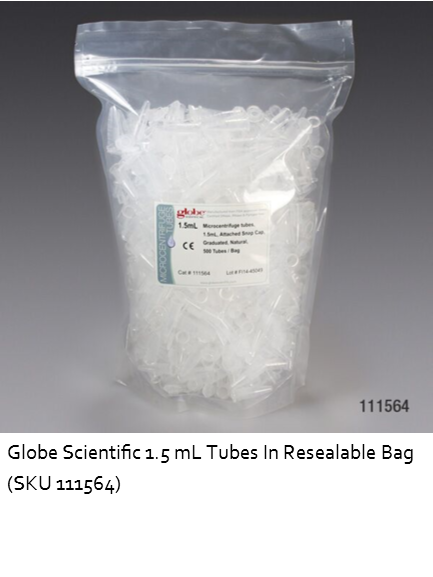 Autoclavability. If microcentrifuge tubes are not sterile, consider whether they can be autoclaved. Autoclavable products can withstand the autoclaving process and allow for sterilization in-lab. Although autoclaving microcentrifuge tubes in-lab requires labor, it is a cost effective alternative to buying pre-sterilized microcentrifuge tubes. Be careful to ensure that your tubes can be autoclaved prior to sterilizing them in an autoclave. Attempting to sterilize tubes that are not autoclavable may cause them to deform, melt, and damage the autoclave.
Autoclavability. If microcentrifuge tubes are not sterile, consider whether they can be autoclaved. Autoclavable products can withstand the autoclaving process and allow for sterilization in-lab. Although autoclaving microcentrifuge tubes in-lab requires labor, it is a cost effective alternative to buying pre-sterilized microcentrifuge tubes. Be careful to ensure that your tubes can be autoclaved prior to sterilizing them in an autoclave. Attempting to sterilize tubes that are not autoclavable may cause them to deform, melt, and damage the autoclave.
 Buying Tip. Remember that an autoclaved product may not be suitable for sensitive applications such as qPCR. This is because autoclaving WILL NOT denature all RNases. Most DNases will be denatured during autoclaving procedures though, so autoclaved tubes or vials may be suitable for DNA storage.
Buying Tip. Remember that an autoclaved product may not be suitable for sensitive applications such as qPCR. This is because autoclaving WILL NOT denature all RNases. Most DNases will be denatured during autoclaving procedures though, so autoclaved tubes or vials may be suitable for DNA storage.
Autoclaving Tip. Cap and tube materials may differ. While the tube material may be autoclavable, the cap may not be. Lookout for varying tube and cap materials in the product description if you plan on autoclaving both.
Skirt
Some microcentrifuge tubes include what is known as a skirt. A skirt allows the tube to stand without assistance from a rack. This can be useful when transporting and filling tubes as skirted microcentrifuge tubes are self-standing.
Surface Type
The surface type refers to the inner surface of the microcentrifuge tube. Microcentrifuge tubes may be treated with silicone or have a chemically inert, low binding surface allowing for optimal sample recovery. Low binding surfaces allow for minimal sample loss and greater precision between aliquots, assuming your sample is well mixed.
Relative Centrifugal Force
Relative centrifugal force (RCF or G-force) pertains to the outward force that individual microcentrifuge tubes will experience while being spun in a centrifuge. The RCF rating (e.g., 30,000 x g) is the maximum RCF a microcentrifuge tube can withstand. RCF is therefore crucial in determining centrifugation settings. Too high an RCF can cause microcentrifuge tubes to shatter or caps to come off, spilling both valuable and potentially hazardous samples everywhere.
Buying Tip. If you need to spin a microtube for sedimentation, consider purchasing a tube with a high RCF tolerance.
What About RPM? RPM, or rotations per minute, defines how many rotations a centrifuge will complete within a minute. RPM alone does not determine the outward force applied to each microcentrifuge tube. Because the radii of centrifuges differ, so will the force. For example, a centrifuge with a 100 mm radius spun at 1000 RPM will apply an RCF of 112 g whereas a centrifuge with a 50 mm radius spun at 1000 RPM will apply an RCF of 56 g. RPM can be converted to RCF using this formula: RCF = 1.12 x Radius (in mm) x (RPM/1000)^2.
Color
Microtube clarity and color, though often overlooked, are important attributes of a microtube. Clear microtubes are useful for viewing samples, whereas amber or black microtube can be utilized to store photosensitive reagents such qPCR master mix. Other colors may be used for organizational purposes.
Buying Tip. There is confusion surrounding clear and natural colored microcentrifuge tubes. Naturally colored tubes have a clouded appearance that can obscure the sample during viewing, while clear tubes allow for unobscured viewing of the sample.
Packaging
Packaging is an important but often overlooked aspect of the purchasing process. Microcentrifuge tubes are sold in either bulk packaging or cases. Bulk packaged microtubes will arrive in one, often large, bag. A cost effective but lab pace intensive purchase. A case will ship with individual bags of microtubes. For example, a case of 1,000 microtubes contains 5 packs of 200 microcentrifuge tubes whereas a bulk package would contain all 1,000 microcentrifuge tubes in one bag. Packaging definitions vary per vendor.
This is the first of many buying guides to come. If you have any suggestions for future buying guides or questions concerning this one, please contact us at support@sycamorebio.com. Otherwise, please rate this post and leave a comment below. Thanks for reading!


